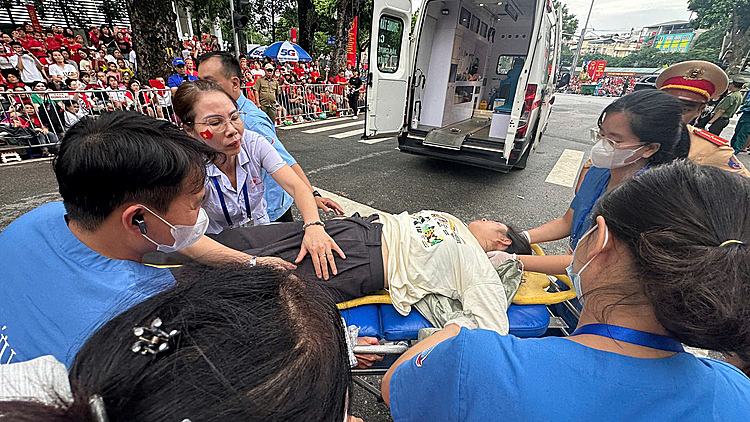A total of 439 individuals received on-site treatment, while 43 required hospitalization. The highest number of cases, 213, occurred during the final rehearsal on 30/8. Of these, 19 were hospitalized, and the rest received on-site care. Patients primarily presented with dizziness, mild convulsions, fainting, limb tremors, heatstroke, nausea, headaches, abdominal pain, allergies, shortness of breath, low blood pressure, high blood pressure, and digestive issues.
For instance, on Lieu Giai - Van Cao street, many people who lined up early to watch the parade experienced fatigue, shortness of breath, and hypocalcemia by the afternoon. They were taken to medical tents for first aid, where doctors administered calcium injections and infusions. In another case, a 77-year-old woman with underlying diabetes and a left femoral fracture fell at Thong Nhat Park and was transported to Post Office Hospital II by the 115 Emergency Center. She is scheduled for left femur surgery once her blood sugar stabilizes.
The Department of Health deployed 370 medical personnel, 37 ambulances, and other vehicles, forming 94 on-site emergency teams during the rehearsals. Three epidemic prevention teams and three food safety teams were also deployed. Additional teams were stationed at units like the A80 Command Center at the 115 Emergency Center, the main emergency center (Xanh Pon General Hospital, Hanoi Heart Hospital), other medical facilities, and crowded areas.
"Medical forces were mobilized to respond promptly to any potential medical situations," a representative of the Department of Health said.
 |
Medical staff attend to a person who fell ill during a parade rehearsal. Photo: Department of Health |
Medical staff attend to a person who fell ill during a parade rehearsal. Photo: Department of Health
Doctors advised attendees to prioritize their health during parades due to the potential risks, including physical strain and environmental factors.
Many people travel as early as 3-4 a.m. to secure good viewing spots, disrupting their sleep cycles and reducing their stress tolerance. Prolonged walking and standing for hours in crowds can cause muscle fatigue, lower limb circulatory stasis, and fainting (syncope). Sleep deprivation, heat, and prolonged standing exponentially increase the risk of medical incidents.
Hanoi's early September climate typically ranges from 26-31°C, potentially reaching 35-36°C, with high humidity that reduces sweat evaporation and increases the heat index. This raises the risk of heat cramps, heat exhaustion, and life-threatening heatstroke. Sudden downpours can also cause chills and wet clothing, leading to rapid heat loss.
At busy intersections like Hung Vuong - Nguyen Thai Hoc, Cua Nam, and Kim Ma - Lieu Giai, dense crowds increase the risk of injuries like falls, bruises, and sprains. Limited access for medical personnel in these areas elevates the risk of fatalities from cardiac events, fainting, or heatstroke. Beyond physical impacts, individuals may also experience psychological stress, anxiety, and panic in crowded situations.
To mitigate environmental impacts, attendees should wear hats and sunglasses for sun protection. Carrying a light raincoat or small umbrella is advised for sudden rain, prioritizing compact options. Other recommended items include bottled water (at least 1-2 liters per person), snacks (bread, fruit, milk), a hand fan or small battery-powered fan, sunscreen, and a cold pack for rapid cooling.
48 hours before the event, individuals should hydrate, consume electrolytes, have a complex carbohydrate-rich dinner, and a light but energizing breakfast. Catching up on sleep for at least two nights prior is crucial, as is researching routes, parking, and viewing locations.
During the parade, attendees should sip water frequently, eat small snacks every 2-3 hours, and rest in the shade when possible. Early signs like headaches, dizziness, and cramps should not be ignored.
Children, particularly vulnerable to dehydration, should wear wide-brimmed hats and carry identification. Elderly individuals, prone to falls, should avoid crowded areas and be accompanied by others. Pregnant women and those with chronic illnesses should consult a doctor before attending and prioritize well-ventilated areas, avoiding crowds.
Symptoms like fatigue, dizziness, cold skin, and a weak, rapid pulse require moving to the shade, elevating the legs, and applying a cold compress. Heatstroke indicators include hot, dry skin, a body temperature above 40°C, confusion, and unconsciousness. Immediate cooling measures (pouring water, fanning, applying cold packs), calling for emergency assistance, and withholding fluids if the person is confused are crucial.
Individuals experiencing hypoglycemia, marked by tremors, sweating, a rapid heartbeat, and intense hunger, should consume sugary drinks or candy followed by carbohydrates. In emergencies, seek assistance from nearby police, security personnel, or volunteers for medical help.
Thuy Quynh












